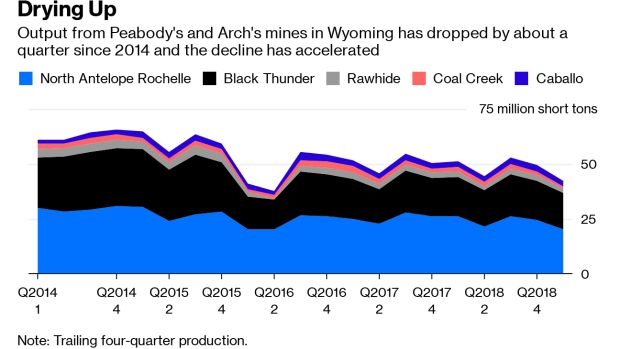Jun 19, 2019
Frackers Get Not One But Two Coal-Mine Canaries
, Bloomberg News

(Bloomberg Opinion) -- Wyoming’s Powder River Basin has been generating some buzz in oil and gas circles as a potential source of new supply (as if oil and gas need that). On Wednesday, though, its real significance was as a strategic signpost.
The PRB, as it is known, is more famous for coal; and two of the biggest miners, Peabody Energy Corp. and Arch Coal Inc., are throwing their lot there together. A planned joint venture will combine five mines in Wyoming and Colorado into a single operation producing more than 60% of the basin’s coal. It will be roughly two-thirds owned by Peabody, with Arch taking the rest.
The PRB produces a cheaper form of coal, with lower energy content, relative to what comes out of Appalachia – and its market is crumbling. Cheap shale gas, renewable energy and flat consumption have cut coal use in U.S. power plants by almost 40% over the past decade. Despite creative attempts by the White House to reverse that trend, the Energy Information Administration expects it to drop by another 19% through the end of next year. Cloud Peak Energy Inc., which operates several PRB mines, is currently in chapter 11 – from which both Peabody and Arch have only emerged themselves within the past few years. And the combined output of their mines in Wyoming, which constitute the vast majority of the joint venture’s output, has dropped away:
So Arch and Peabody want to get those assets together, squeeze out costs and try to be the last guy(s) standing. The two miners expect synergies they value at $820 million, or roughly a fifth of their combined market cap. That alone is reason to try. It also puts some distance between the PRB assets and the companies’ metallurgical-coal operations, where prospects (and profits) are better.
This is a textbook deal for two commodity producers faced with terminal decline in their market. For Arch, it continues a strategy of rejecting the growth impulse that pushed much of this industry into chapter 11 within the past decade in favor of a more realistic approach that has shrunk the company. Arch has bought back almost a third of its stock in the past few years, generating healthy returns at odds with the industry’s broader fortunes (see this). The stock jumped as much as 8% on Wednesday morning and is close to its post-bankruptcy peak.
Frackers in shale would do well to take this on board. Oil and gas markets aren’t facing the same pressure as U.S. thermal coal, but are also challenged. Natural gas demand isn’t growing quickly enough to absorb surging production; and neither is oil, judging from its comatose state in the face of all sorts of geopolitical provocations. Despite some consolidation, the Permian basin, especially, remains very fragmented, and legacies of poor returns and weak governance keep investors on the sidelines. Having shown some progress on living within their means last year, frackers once again outspent cash flow in the first quarter.
Consolidation – especially in the form of nil-premium, all-stock deals – would go a long way to cutting the bloated overhead that comes from having dozens and dozens of companies targeting the same acreage. It’s not often a literal canary in the coal mine shows up, let alone two.
To contact the author of this story: Liam Denning at ldenning1@bloomberg.net
To contact the editor responsible for this story: Mark Gongloff at mgongloff1@bloomberg.net
This column does not necessarily reflect the opinion of the editorial board or Bloomberg LP and its owners.
Liam Denning is a Bloomberg Opinion columnist covering energy, mining and commodities. He previously was editor of the Wall Street Journal's Heard on the Street column and wrote for the Financial Times' Lex column. He was also an investment banker.
©2019 Bloomberg L.P.


